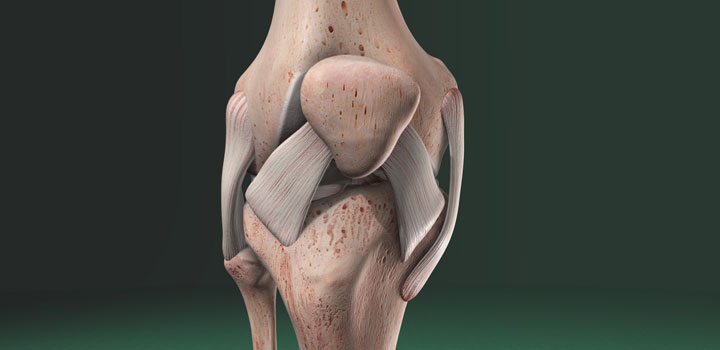Partial Knee Resurfacing
There are many causes of knee pain and there is a variety of treatment options. This section will review the causes and treatments of knee pain, highlighting more conservative knee treatment. Alleviating the pain and restoring mobility in your knee may allow you to do the simple things — from walking to gardening — even playing with your grandchildren, and most importantly, just enjoy life again. Information is the first step toward potential relief from joint pain.
Knee Anatomy
The knee is the largest joint in the body and is essential to nearly every routine activity. The knee joint is formed by the ends of 3 bones: the lower end of the thigh bone (femur), the upper end of the shin bone (tibia), and the knee cap (patella). Thick, tough tissue bands called ligaments connect the bones and stabilize the joint.
A smooth, plastic-like lining called cartilage covers the ends of the bones and prevents them from rubbing against each other, allowing for flexible and nearly frictionless movement. Cartilage also serves as a shock absorber, cushioning the bones from the forces between them. Finally, a soft tissue called synovium lines the joint and produces a lubricating fluid that reduces friction and wear.
What causes my joint pain?
Normally, all of the parts of the knee joint work together and the joint moves easily and without pain. However, diseases or injury can disturb the normal functioning of the joint resulting in pain, muscle weakness, and limited movement. Arthritis pain affects more than 40 million Americans.1 If you’re reading this website, you may be one of them. Click on the headings below to learn more about three types of arthritis.
Osteoarthritis (OA)
One of the most common causes of knee pain and loss of mobility is the wearing away of the joint’s cartilage lining. When this happens, the bones rub against each other, causing significant pain and swelling — a condition known as osteoarthritis.
Trauma or direct injury to the knee can also cause osteoarthritis. Additionally, without cartilage there is no shock absorption between the bones in the joint, allowing stress to build up in the bones and contributing to pain.
Osteoarthritis is probably the most common joint disorder in the United States, affecting approximately 20 million people.1
Rheumatoid Arthritis (RA)
Rheumatoid Arthritis is a disease that affects approximately 2.1 million1 individuals in the U.S.; women are affected about three times more often than men.
The synovial membrane (the membrane that surrounds the joint) becomes thickened and inflamed. Too much synovial fluid (the fluid that lubricates the joint) is produced within the joint space and chronic inflammation damages the cartilage and cartilage loss, pain, and stiffness result.
Post-Traumatic Arthritis
Post-traumatic Arthritis may develop after an injury to the joint. The bone and cartilage do not heal perfectly, so the joint is no longer smooth and these irregularities lead to more wear on the joint.
Treatment Options for Arthritis
Following an orthopedic evaluation, your orthopedic specialist will review and discuss the results with you. Based on his or her diagnosis, your treatment options may include:
- Medication
- Physical therapy
- Knee joint fluid supplements
- Arthroscopy
- Knee joint resurfacing
When non-invasive treatment options are not giving you satisfactory pain relief, knee surgery may become necessary. However, a total knee replacement may not be necessary — alternate types of knee implants are available. Click on the headings below to learn more about treatment options for knee arthritis.
Partial Knee Resurfacing (PKR)
There are three compartments to the knee: the medial (inside) compartment, the lateral (outside) compartment and the patellofemoral (kneecap) compartment. Depending on where the arthritis affects your knee, partial knee resurfacing may be an option for you. There are approximately 56,900 partial knee resurfacing procedures done in the U.S. each year.2
Partial knee resurfacing is a surgical procedure for relieving arthritis in one compartment of the knee. With PKR, only the damaged surface of the knee joint is replaced, minimizing trauma to healthy bone and tissue. The surgeon removes only damaged bone in the affected knee and fits the implant to that bone surface.
Potential Benefits of PKR
Because the PKR artificial joints are smaller than total knee implants, the surgical incision may be smaller as well. A smaller incision may lead to a smaller scar. Other potential benefits to PKR include a quicker operation and a shorter hospital stay compared to a total knee replacement.3 Because less bone is removed and there is less trauma to soft tissue during surgery, your knee may feel more natural than a total knee replacement.
Since most of the knee joint is unaffected and the basic knee structure remains intact, post-operative pain may be reduced and the recovery period may be shorter than total knee replacement.3 Rehabilitation may also be more progressive. Some patients leave the hospital after a short overnight stay, and may not even require physical therapy. A few gentle exercises and walking may be the only rehabilitation needed.
Not all patients are candidates for a Partial Knee Resurfacing. Depending on your condition, a total knee replacement may be recommended by your doctor.
Unicompartmental Knee Resurfacing
Unicompartmental knee implants, like the EIUS® Unicompartmental Knee System, were developed with patient needs in mind. The implant is anatomically shaped and enables surgeons to use the latest minimally invasive surgical techniques for this procedure. With this procedure, only the end of the arthritic femur and the tibia are resurfaced with artificial implants.
Patellofemoral Knee Resurfacing
Patellofemoral pain (anterior knee pain) is pain felt between the patella (kneecap) and the thighbone. Patellofemoral Knee Resurfacing is a procedure that resurfaces the worn patella and the trochlea (the groove at the end of the thighbone) to alleviate this pain.
With the Avon® Patellofemoral Knee System, joint resurfacing may be an alternative to total knee replacement for patients with patellofemoral arthritis. It is designed to reproduce the natural patellofemoral joint throughout movement and facilitate sliding of the patella along the end of the thighbone. It is also designed to produce a natural-feeling knee with comfortable and reliable function.
The Avon® Patellofemoral Knee System is the only one with up to 5 years of published clinical results with 90% success in over 100 knees.4
Following a patellofemoral knee resurfacing, you may be able to get up and walk on the first post-operative day and start an active range of knee movement. Ninety degrees of knee movement may possibly be achieved within 4-6 days; patients can be discharged within this period.
All knee implants (including total knee implants) have a limited life expectancy. Based on your age, weight, and activity level, a PKR implant can relieve pain and last for a number of years.
Total Knee Replacement
Total Knee Replacement (TKR) may be necessary if more than one compartment of your knee is arthritic. In TKR, your surgeon will resurface all 3 compartments of your knee using total knee components.
Even with total knee replacement, your orthopedic surgeon may choose to use the latest minimally invasive surgical techniques (MIS) for this procedure. Minimally invasive knee surgery is performed through a 3 to 4 inch incision and may also reduce the amount of soft tissue (muscles and tendons, etc.) disrupted during surgery. With MIS knee surgery, there may be less blood loss, possibly a shorter hospital stay and less rehabilitation.5
Risks Associated with PKR/TKR
As with any surgery, there is a risk of complications. Blood clots are the most common complication after surgery. Your orthopedic surgeon may prescribe one or more measures to help prevent blood clots from forming in your leg veins, such as special support hose and blood thinners. You may also receive antibiotics to help prevent infection. Your orthopedic specialist can provide you with more information about other potential risks.
Only your orthopedic specialist can properly evaluate whether you are a candidate for a knee joint surgery procedure. Risk factors relating to your anatomy, weight, prior joint surgeries and your personal health should be addressed with your orthopedic specialist.
You Don’t Have to Live with Joint Pain
You don’t have to live with joint pain and the limitations it puts on your activities.
Knee resurfacing may relieve your pain and restore the function in your knee. Today’s knee implant designs may allow your knee to bend and rotate like a normal knee. Talk to your orthopedic specialist today about the treatment options that may provide the pain relief you long for and enable you to return to your favorite activities.
Take an interactive self-assessment at: www.aboutStryker.com
References
- National Institute of Arthritis and Musculoskeletal Diseases Website, November 2005.
- 2005 Projection, Millennium Research Group, 2005.
- Newman, John H., Unicompartmental Knee Replacement, The Knee, 7 (2000), pp. 63-70.
- Ackroyd, Christopher E., Development and Early Results of a New Patellofemoral Arthroplasty, Clinical Orthopedics and Related Research, Vol. 436, July 2005, pp. 7-13.
- White, R., Allman, J., Trauger, J., Dales, B., Clinical Comparison of the Midvastus and Medial Parapatellar Surgical Approaches. Clinical Orthopaedics and Related Research, 1999; 367: 117-122.


